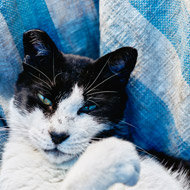
Photographs will help raise funds for welfare work
The winners of International Cat Care’s (iCatCare) 2017 ‘Street Cats’ photography competition have been announced.
Catan Ngan from Hong Kong was crowned overall winner for his stunning image of a Hong Kong community cat (pictured). Judges said they were wowed by its striking composition, colours and the sheer presence of the cat photographed.
Catan is set to receive £500 in prize money and his image will grace the cover of iCatCare’s 2018 calendar.
Congratulations also go to: Jonas Chan (Hong Kong), Mei Catherall (UK), Chi Keung Wong (Hong Kong), Rachel Hunter (UK), Sayed Mohammad Fallah Firouzkouhi (UK), Christine Lam Ying Loi (Hong Kong), Igor Taranenko (Ukraine), Tulyawat Mahawong (Thailand) and Heiko Damme (Germany).
Launched in April, this year’s photography competition aimed to raise awareness of the plight of street cats to inspire change.
The iCatCare judges received more than 2000 images from photographers in 56 different countries. The images featured pictures of cats living in a relatively good condition where Trap Neuter Return (TNR) is practised to heart-wrenching photographs of cats in very poor conditions.
The charity was looking for images which captured the character of these amazing cats surviving without owners and which really reflect life on the streets.
“Although picking the winners is hard, it’s a testament to the high quality of the entries we receive,” said Eve Davies, who ran this year’s competition. “It can be a difficult job but it’s hugely rewarding because all the wonderful photographs that we find for our annual charity calendar which is sold to raise funds for our welfare work.”
To see all the winning images visit www.icatcare.org/photography-competition/2017.
Image (C) iCatCare/Catan Ngan



 The RCVS has announced a new version of its 1CPD mobile app, with enhanced features for veterinary surgeons and veterinary nurses to record their continuing professional development.
The RCVS has announced a new version of its 1CPD mobile app, with enhanced features for veterinary surgeons and veterinary nurses to record their continuing professional development.